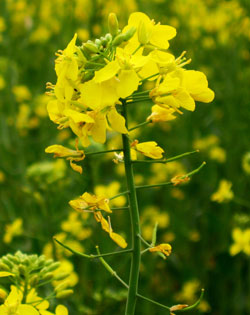Flowering Plants
What are flowering plants?

A flowering plant (angiosperm) is nothing more than a seed producing plant that has clusters of spore-bearing leaves surrounded by whorls of protective and often albeit attractive leaves.
Dicots and monocots are the primary groups of flowering plants.
Typically, flowering plants are organized into an underground root with a shoot above ground that consists of a stem and leaves.
The organs of a plant that serve sexual reproduction are the flowers. Part of the pollinated flower ripens and becomes the fruit.
In contrast to many other plant groups, flowering plants are striking and common. These sporophytes (see Plant Evolution) are the most important group of the primary producers, which dominates the landscape around us, with over 250,000 species described.
Origins of flowering plants

The flowering plants emerged in the Cretaceous period (see Geological Time), some 130 million years ago. They dramatically changed the Earth's landscapes, quickly taking over most of the ecological functions.
These fast-growing, adaptable plants also gave rise to a huge boom in the dinosaurs world. Most of the dinosaurs that have been found date from the late Cretaceous period, when flowering plants were supplying plant-eating dinosaurs (like hadrosaurs) with plentiful and nutritious food.
Some Mesozoic Era angiosperms included magnolias, laurel, barberry, early sycamores, and palms. Grasses may have evolved later. Cretaceous vegetation was increasing in density and species diversity as the quick-to-adapt flowering plants radiated throughout the world.

The Magnolia flower shows many features of the earliest flowers. Spirally arranged microsporophylls (anthers) and megasporophylls (carpels) are surrounded by non-spore-bearing leaves (petals and sepals which together are termed the perianth).
The earliest pollinators were just beetles chomping their way through flowers, accidentally spreading pollen and, in view of the bounty of flower parts, sparing some carpels to form seed and fruit. The insects and flowers co-evolved causing the flower structure and insect mouth parts to evolve.
Their importance

Flowering plants generate oxygen, which is the prerequisite for life on Earth. Green plants have the ability to convert solar energy into chemical energy via the process of photosynthesis (see Plant Evolution), which produces the oxygen necessary for all organisms on Earth to live.
The useable plants among the flowering plants are the basis of human existence and are too an important economical factor.